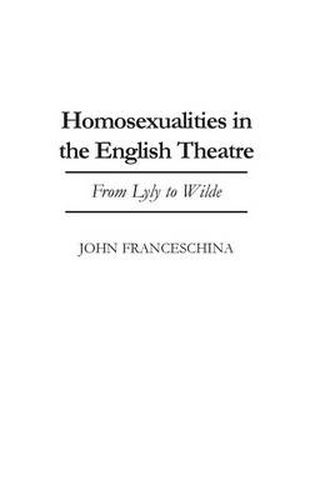Readings Newsletter
Become a Readings Member to make your shopping experience even easier.
Sign in or sign up for free!
You’re not far away from qualifying for FREE standard shipping within Australia
You’ve qualified for FREE standard shipping within Australia
The cart is loading…






Scholars have given increasing amounts of attention to the place of homosexuality in different periods of English cultural and literary history. This book is a broad survey of representations of homosexuality in the English theatre from the Renaissance to the late 19th century. It draws on scholarship from a wide range of disciplines, including sociology, history, psychology, literature, and drama. The first chapter provides a background for the book by discussing the nature of same-sex behavior in the ancient and medieval worlds. The chapters that follow discuss such topics as sodomy and transvestite theatre in the Renaisssance; female transvestism on the English stage during the 17th century; bisexuality in 18th-century drama; the rise of English homophobia and the proliferation of lesbian relationships in England between 1745 and 1790; the homophobic context of English theatre during the Romantic Movement (1790-1835); and the rebirth of interest in Greek thought and its associations with same-sex poetry, drama, and pornography in the Victorian era (1840-1900).
Scholars have given increasing amounts of attention to the place of homosexuality in English literature and culture. Dramatic works are a reflection of cultural issues, and thus they sometimes treat homosexual subject matter. But because plays are enacted, they also represent homosexual concerns through staging conventions, such as the use of young boys to play female roles during the Renaissance. While some scholars have examined homosexuality in particular plays, this volume is a broad survey of the representation of same-sex relationships on the English stage from the Renaissance to the close of the 19th century. It draws on scholarship from a wide range of fields, including sociology, history, psychology, literature, and drama to provide a sweeping, multidisciplinary account of homosexuality and English Drama.
Modern drama has its roots largely in the Renaissance, and Renaissance drama, in turn, drew heavily from classical culture and medieval dramatic traditions. Thus the first chapter of the book provides a background discussion of same-sex behavior in the ancient and medieval worlds. The chapters that follow discuss such topics as sodomy and transvestite theatre in the Renaissance; female transvestism on the English stage during the 17th century; bisexuality in 18th-century drama; the rise of English homophobia and the proliferation of lesbian relationships in England between 1745 and 1790; the homophobic context of English theatre during the Romantic Movement (1790-1835); and the rebirth of interest in Greek thought and its associations with same-sex poetry, drama, and pornography in the Victorian era (1840-1900). The playwrights discussed include major figures such as Marlowe, Shakespeare, Jonson, Shelley, and Wilde, along with less frequently read authors such as John Marston, Thomas Dekker, and Barnabe Barnes.
$9.00 standard shipping within Australia
FREE standard shipping within Australia for orders over $100.00
Express & International shipping calculated at checkout
Scholars have given increasing amounts of attention to the place of homosexuality in different periods of English cultural and literary history. This book is a broad survey of representations of homosexuality in the English theatre from the Renaissance to the late 19th century. It draws on scholarship from a wide range of disciplines, including sociology, history, psychology, literature, and drama. The first chapter provides a background for the book by discussing the nature of same-sex behavior in the ancient and medieval worlds. The chapters that follow discuss such topics as sodomy and transvestite theatre in the Renaisssance; female transvestism on the English stage during the 17th century; bisexuality in 18th-century drama; the rise of English homophobia and the proliferation of lesbian relationships in England between 1745 and 1790; the homophobic context of English theatre during the Romantic Movement (1790-1835); and the rebirth of interest in Greek thought and its associations with same-sex poetry, drama, and pornography in the Victorian era (1840-1900).
Scholars have given increasing amounts of attention to the place of homosexuality in English literature and culture. Dramatic works are a reflection of cultural issues, and thus they sometimes treat homosexual subject matter. But because plays are enacted, they also represent homosexual concerns through staging conventions, such as the use of young boys to play female roles during the Renaissance. While some scholars have examined homosexuality in particular plays, this volume is a broad survey of the representation of same-sex relationships on the English stage from the Renaissance to the close of the 19th century. It draws on scholarship from a wide range of fields, including sociology, history, psychology, literature, and drama to provide a sweeping, multidisciplinary account of homosexuality and English Drama.
Modern drama has its roots largely in the Renaissance, and Renaissance drama, in turn, drew heavily from classical culture and medieval dramatic traditions. Thus the first chapter of the book provides a background discussion of same-sex behavior in the ancient and medieval worlds. The chapters that follow discuss such topics as sodomy and transvestite theatre in the Renaissance; female transvestism on the English stage during the 17th century; bisexuality in 18th-century drama; the rise of English homophobia and the proliferation of lesbian relationships in England between 1745 and 1790; the homophobic context of English theatre during the Romantic Movement (1790-1835); and the rebirth of interest in Greek thought and its associations with same-sex poetry, drama, and pornography in the Victorian era (1840-1900). The playwrights discussed include major figures such as Marlowe, Shakespeare, Jonson, Shelley, and Wilde, along with less frequently read authors such as John Marston, Thomas Dekker, and Barnabe Barnes.